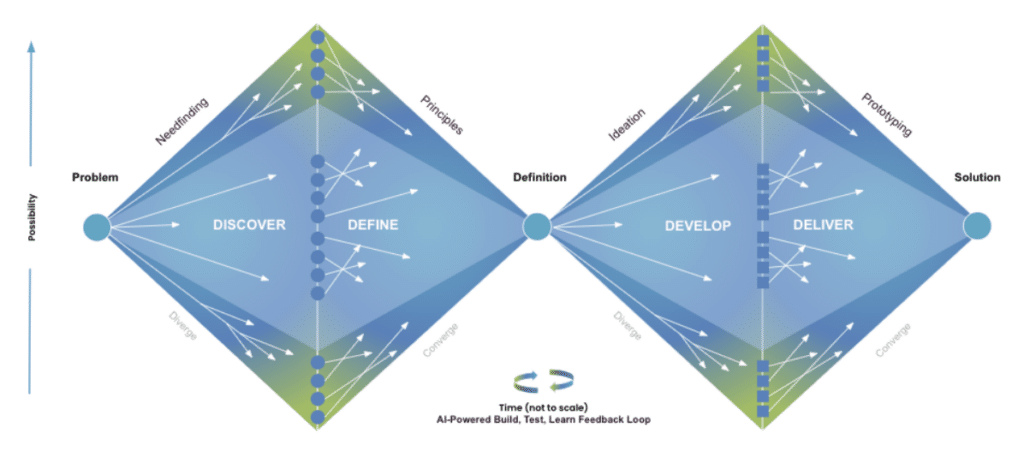Contents
The Double Diamond 20 Years Later: Reinvented by AI, Grounded in Human Empathy
In 2005, the Double Diamond revolutionized how we approach problem-solving in design. It taught us the value of diverging to explore possibilities and converging to refine solutions—a balance of creativity and structure that empowered designers to tackle complex challenges. But today, as we stand on the threshold of 2025, the design landscape has transformed in ways few could have imagined.
Artificial intelligence has entered the scene as a powerful force, reshaping every corner of our creative process. What does that mean for the Double Diamond? Far from being outdated, this framework is more relevant than ever—augmented and expanded by AI to reach new heights. The question isn’t whether the Double Diamond can withstand the era of AI but how it can thrive because of it.
Why the Double Diamond Still Matters
The Double Diamond persists because it taps into something universal: our need for structure in the face of complexity. At its heart, the framework is about understanding human needs, defining clear goals, exploring creative solutions, and delivering results that resonate. These principles are timeless.
Yet, the challenges we face as designers today are evolving. In a world of hyper-accelerated timelines and rapidly shifting user expectations, designers are under immense pressure to innovate faster while maintaining quality and empathy. The Double Diamond remains a trusted guide, helping teams stay grounded in the fundamentals of human-centered design even as AI accelerates our capabilities.
The value of the Double Diamond isn’t just in its structure—it’s in its adaptability. And with AI as an enabler, the opportunities for innovation are boundless.
AI as the Catalyst for Expansion
The Simulation Era has unlocked new ways to navigate each phase of the Double Diamond, breaking down barriers that once constrained the speed and depth of design work. Here’s how AI transforms every stage of the framework:
1. Discover: Broadening the Lens of Possibility
Traditionally, the Discover phase relied on manual research, interviews, and surveys—time-intensive processes that could limit scope and scale. AI changes this dynamic. Tools like WEVO Pulse use simulated audiences to generate directional insights within minutes, identifying user pain points, preferences, and opportunities at a fraction of the time and cost.
Imagine designing for a global audience. With AI, you can instantly gather perspectives from diverse demographics, uncovering patterns and preferences that would have taken weeks to analyze. This broader lens empowers designers to think beyond their immediate contexts, setting the stage for more inclusive and impactful solutions.
2. Define: Deepening Understanding with Precision
Defining the problem has always been one of the trickiest steps—misinterpretation here can derail an entire project. AI-powered sentiment analysis and diagnostic tools provide clarity by pinpointing the emotional responses and behavioral trends that matter most.
For instance, WEVO’s diagnostic scoring doesn’t just surface issues; it reveals why users are struggling. By layering these insights with AI-driven context, designers gain a richer understanding of the problem space, enabling sharper focus and more precise problem statements.
3. Develop: Supercharging Creativity with AI Co-Creation
The Develop phase is where AI’s generative capabilities truly shine. Imagine being able to produce dozens of prototypes overnight, each informed by real user data and optimized for specific personas. This kind of iteration speed allows designers to test more ideas, fail faster, and zero in on the most promising concepts.
But AI’s role isn’t just about volume—it’s about partnership. Tools that integrate agentic AI can simulate user interactions with these prototypes, providing immediate feedback on usability, accessibility, and overall impact. The result? Teams can refine their ideas with confidence, knowing they’re grounded in data-driven insights.
4. Deliver: Ensuring Success Beyond the Finish Line
The Deliver phase is no longer just about launching a product—it’s about learning from the launch to continuously improve. AI-driven post-launch analytics allow teams to monitor real-time user behavior, predict future trends, and identify opportunities for optimization.
For example, AI can simulate how users might interact with new features or changes, helping teams de-risk decisions before they go live. By integrating AI into the delivery process, designers can ensure their solutions not only meet expectations but evolve with user needs.
Practical Takeaways for 2025
If you’re ready to embrace the AI-augmented Double Diamond, here are three actionable steps to get started:
- Lean into AI for Discovery: Use tools like WEVO Pulse to gather rapid insights, but pair them with direct user engagement to validate findings and maintain a human touch.
- Expand Your Prototyping Process: Let AI handle the heavy lifting of generating and testing ideas so your team can focus on refining the ones that truly resonate.
Stay Anchored in Empathy: Use AI as a means to deepen your understanding of users, not as a shortcut to replace it. Prioritize tools that amplify human-centered design principles.
The Tension Between Speed and Depth
The Double Diamond’s strength lies in its ability to balance exploration and focus, but introducing AI into the process creates an undeniable tension between speed and depth. When insights can be generated within minutes, there’s a temptation to rely solely on AI-driven recommendations. While speed is an asset, it’s critical to remember that not all problems are solved by faster iterations.
The key is knowing when to lean into AI and when to pause for deeper human engagement. For example:
- Use AI in the Discover phase to rapidly gather directional insights from broad audiences, but validate findings with smaller, qualitative studies to capture cultural nuances or emotional depth.
- In the Develop phase, let AI help you generate and test multiple prototypes at speed. Then, involve human stakeholders to prioritize concepts that align with strategic goals and user values.
The tension between speed and depth isn’t a limitation—it’s a choice. By blending the efficiency of AI with the empathy and creativity of human designers, we can achieve the best of both worlds.
The Future of Design is Collaborative
The Double Diamond isn’t changing because it’s outdated—it’s evolving because AI has given us tools we couldn’t dream of a decade ago. But this evolution comes with a challenge: How do we preserve the human-centered heart of design in a world increasingly driven by technology?
The answer lies in collaboration. AI is not a replacement for human intuition or empathy—it’s an amplifier. It helps us uncover patterns, test ideas, and validate concepts faster, but it’s our responsibility as designers to bring those insights to life in ways that resonate with real people.
The Simulation Era offers us a unique opportunity to reimagine what design can achieve. By integrating AI into the Double Diamond, we’re not just creating faster workflows—we’re opening the door to deeper insights, bolder creativity, and more inclusive solutions. Let’s use this moment to build a new era of design that’s as empathetic as it is innovative.
Are you ready to embrace the AI-augmented Double Diamond? The future of design awaits—and it starts with us.



